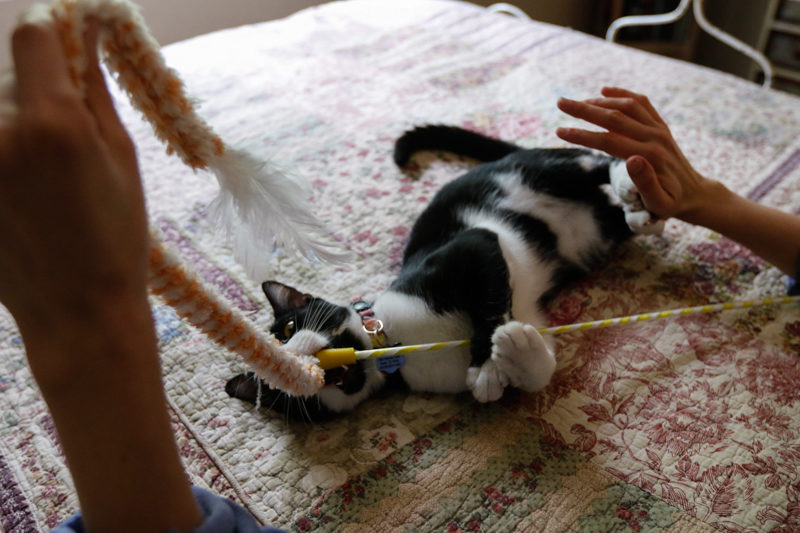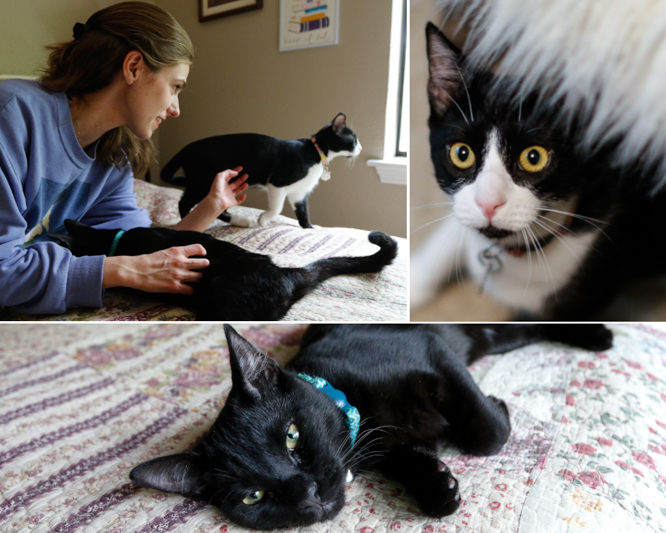Kittens Help Inmates Practice Compassion, Cooperation
By Brennan Patrick
Photography By Denise Cathey
Reporting Texas

Ruth, a kitten adopted from the Kitten Foster Program, plays with her new owner, Shannon Perri, in her home.
Unit 3 of Travis County Correctional Complex looks more PetSmart than cell block. Rainbow-colored balls and other toys pile next to a shelf packed with animal care guides; one yellow spine reads “Kittens for Dummies.” Dander is thick in the air. A calendar tacked on a wall bears hand-scrawled names: Aubrey, Bella, Skyler, Thor and Rebel Blue.
These are the new feline residents of the Kitten Foster Program, a partnership between the Travis County Sheriff’s Office and the Austin Animal Center that teaches inmates how to raise and care for animals until they are ready for adoption. In addition to helping maintain AAC’s status as a no-kill shelter, the program gives inmates the opportunity to learn new skills and practice compassion and cooperation with each other.
At 6 weeks old, the kittens require constant care and supervision, and the inmates are up to the challenge. Although unable to give her name due to jail regulations, one female inmate is eager to discuss her various responsibilities. Rebel Blue, a slender black kitten, stretches gently inside her tattooed hands as she cleans it with soft wipes. No mother cat is present to groom.
Among other duties, the inmates pay special attention to keeping the kittens off the spiral staircase at the cell block’s center; it does look enticingly climbable.
The Austin City Council approved the program unanimously in September 2017, funding it through a combination of grants and money allocated in the $13-million Animal Services budget.
For program coordinator Heather Stan, it was an undertaking stretching more than two years.
The idea hit Stan back in 2015, when she flipped on the news during the devastating October floods and saw spokespeople from the Austin Animal Center asking for help. The center had reached full capacity and was forced to turn away any animal that wasn’t sick or injured. From her position just 10 minutes down the road at the Del Valle complex, Stan knew she could find a way to help.
“I’d seen some (programs) in the past where they incorporate inmates with animals and train them to be service dogs, Seeing Eye dogs . . . I was like, ‘Why could we not do that here?’ ” Stan said.
The Del Valle jail seemed to be an ideal location for such an experiment. Its close proximity to the shelter eased the hassle of transporting animals, and with many inmates serving short sentences for non-violent offenses, Stan knew she had an eligible pool of candidates.
She reached out to Lauralei Combs, the volunteer program manager of the animal center at the time.
“We thought that was a good idea,” Combs said. “Half the inmates come out, and they’re members of our community. Now they’re going to come out knowing things like positive reinforcement training.”
Over the next year, Stan reached out to prisons with similar programs, developing a body of research she would use to win over her captains, majors and Sheriff Sally Hernandez. Although statistical evidence is scant, prisons across the country have seen strong results since the first programs emerged in the 1980s. According to a study published in The Prison Journal, one-third of the 61 prison administrators surveyed reported inmates working with animals after their release, and 60 said they would recommend a pet program to others.
In September 2016, the first-ever dog training classes were held on Travis County jail grounds. By the end of the program, all eight dogs had been adopted.
But Stan’s goal was to have dogs living with the inmates, which required the additional approval of Austin City Council and the Commissioners Court. The Kitten Foster Program was developed as a test run, because kittens require less maintenance. It would take only female applicants, which drew some unexpected backlash.
“I’ve had several people ask me, ‘Is there a reason? Is that kind of sexist?’ ” Stan said. She explained that female inmates are generally released sooner than their male counterparts and would therefore be a better fit for kittens, which would need less time before adoption and develop less intense connections to their handlers than dogs would.
From the 80 inmates who applied, 12 were selected and moved to the smallest unit inside the complex. By mid-December 2017 they were sharing their quarters with four kittens and being visited twice weekly by AAC volunteers who taught them everything from bottle-feeding to trimming claws.
Combs said she saw the benefits extending past those directly involved.
“It’s easier on the staff that works there, the guards,” she said. “Because they’re working now with the best inmates who want to help, who actually take on responsibility. They’re teaching other inmates.” In fact, two officers even applied to adopt.
The first round of four kittens was put up for adoption on Jan. 25. Shannon Perri, an English instructor at Texas State University, stood outside the Austin Animal Center in the driving rain for a chance to see them. She brought home two. She and her husband renamed them Marshall and Ruth, for their favorite Supreme Court justices, Thurgood Marshall and Ruth Bader Ginsburg.

Perri adopted Ruth and her sibling Marshall nearly three months ago from the Kitten Foster Program jointly run by the Austin Animal Center and the Travis County jail. It matches kittens with female inmates to provide care and socialization for the animals until they are ready for adoption.
“These are like the best cats ever,” Perri said. “I think because they were raised with so much attention and like being hand-held so much. So much human contact.”
But that contact can last only so long. After five weeks, the caretakers and kittens had to say their goodbyes. The inmates were taken out of their unit and up to rooms where they could spend some private time with their kittens before they returned to the shelter.
“It is sad, but it’s a good sad,” Stan said. “They know that they did a wonderful thing, they raised these kittens, and they kept them healthy and alive, and they know they’re going to go to a good home.”
Perri was also provided with a journal kept by one of the inmates, filled with notes on caretaking and personal thoughts about the kittens she had to let go. She recalled an entry addressed to any new owners, asking them to give the kittens just as much care and attention as they received behind bars.
“That was just like such an honor,” Perri said, “that I had the chance to continue loving these little kittens.”